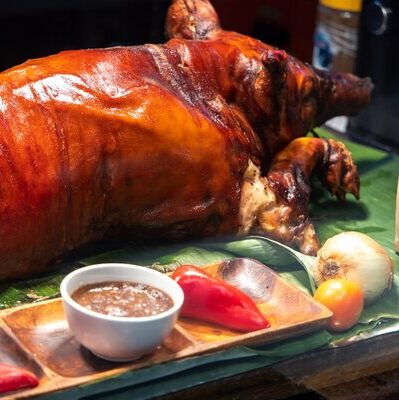
Lechon
What is Lechon?
Lechon is a Filipino dish that consists of a suckling pig roast. It is stuffed with spices like aniseed, herbs, and seasonings, and slow roasted on an open fire spit. This dish is served at celebrations and festive occasions. Presented whole as a single dish, it is often served with a thick liver sauce. This pork roast is such a cultural landmark in the Philippines that the Parada ng Lechon is celebrated in June in the Batangas province.
- The name itself comes from the Spanish lechon, referring to “leche” or milk which the nursing pigs were consuming.
- It is a popular dish in the Philippines, other countries of Southeast Asia, Spain, Portugal, and their erstwhile colonies.
Some of the best Filipino side dishes to accompany this pork roast are:
- Poqui Poqui
- Latik
- Atchara
- Lumpia
- Puto Cheese
- Garlic Fried Rice
- Pan de Sal
- Adobo Mushrooms
- Coleslaw
- Cucumber Tomato Salad
Origin of lechon
There are two possibilities as to the origin of this dish. One theory dictates that it is a dish of Chinese origin, which was brought by trade to the Philippines in the 13th century. Another theory attributes its origin to Spanish colonizers who brought the dish with them in the 16th century. Both China and Spain or Portugal had similar whole suckling pig roast in their cultures, so either theory is feasible. However, it is possible that Filipinos may have hunted and roasted wild boars even earlier.
Nutrition
Nutritional profile for lechon (100 gms):

This dish is rich in potassium, phosphorous, sodium, and lycopene. Also, it contains calcium, magnesium, selenium, vitamin C, niacin, folate, choline, vitamin A, carotene, lutein + zeaxanthin, and fatty acids in decent quantities. Regular consumption of unprocessed lean pork may help in combating diseases like cardiovascular diseases and diabetes. Additionally, it may help weight loss.
Commercial production
Due to the fact that most homes don’t have roast pits, this dish is generally prepared in special lechonerias and then brought to the place of dining. There are several different versions of roast suckling pig.
As a first step, the entrails are removed from the pig and the whole animal is roasted on a rotating spit. Some varieties add stuffing inside of different herbs such as lemongrass, garlic, and tamarind. Finally, the removed entrails are made into a sweet and sour sauce and served along with the roast.
Lechon recipes
There are multiple varieties of lechon in the Philippines. Other countries also have their own versions. Here are a few recipes:
- Lechon Asado
- Lechon Kawali
- Lechon Macau
- Lechon Burger
- Lechon Liempo
- Lechon Cebuano
- Lechon Baboy
- Torta de Lechón
FDA regulations
The USDA regulates all meat products, including pork. It is defined as the meat from hogs or domestic swine, usually produced from animals around 6 to 7 months old. It is considered as a red meat. All pork products are graded based on quality and cleanliness.
References
Robyn Eckhardt, The Dish: Lechon, The Wall Street Journal, https://www.wsj.com/articles/SB119075618625939123
Fresh Pork from Farm to Table, Food Safety and Inspection Service (FSIS), United States Department of Agriculture (USDA), https://www.fsis.usda.gov/food-safety/safe-food-handling-and-preparation/meat/fresh-pork-farm-table
Murphy, Karen J et al. “Effects of eating fresh lean pork on cardiometabolic health parameters.” Nutrients vol. 4,7 (2012): 711-23. doi:10.3390/nu4070711, https://www.ncbi.nlm.nih.gov/pmc/articles/PMC3407990/
